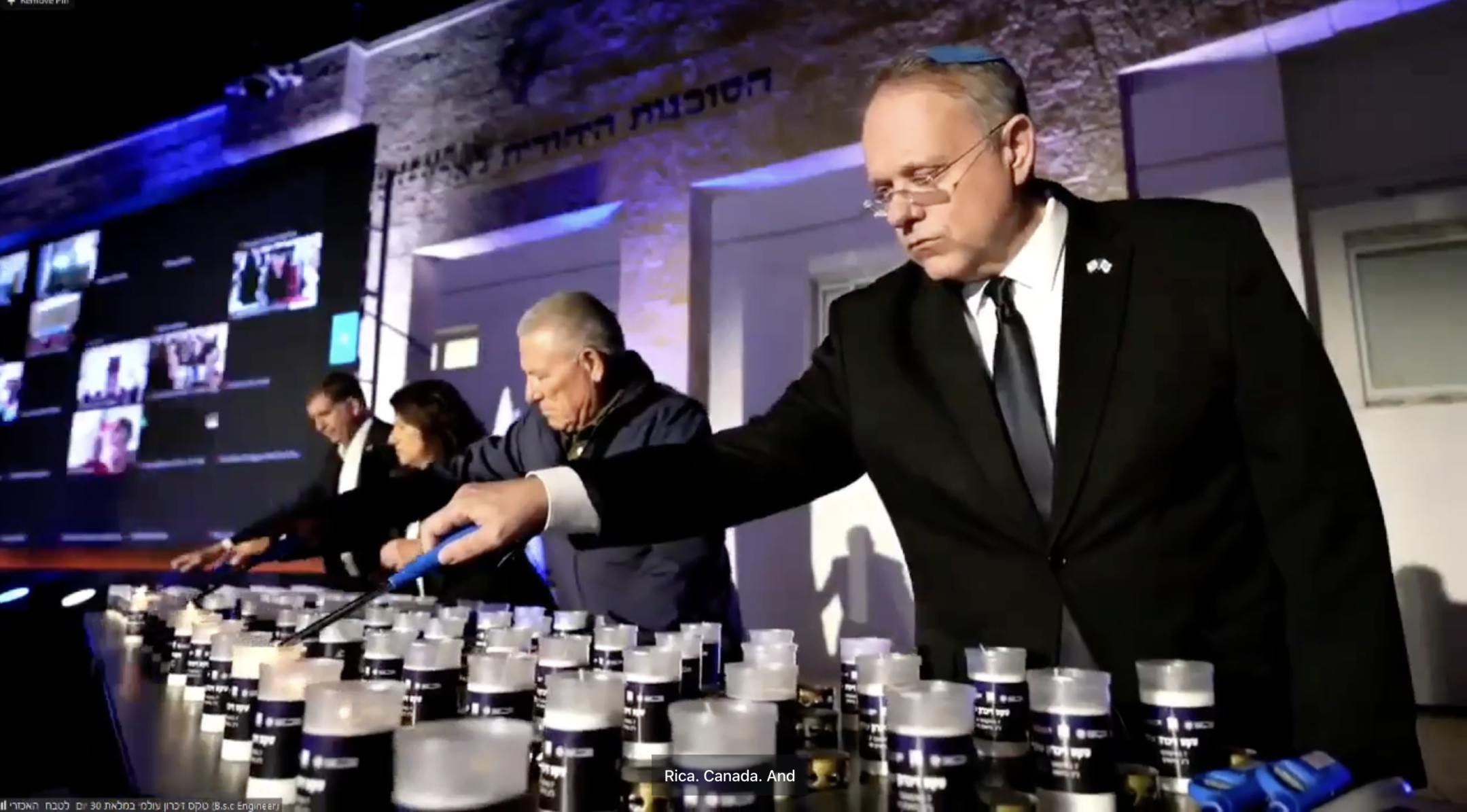30 days after Oct. 7, a Jewish world wracked by grief is marking a traditional milestone of mourning
Shloshim ceremonies are complicated by the fact that the communal loss does not line up with the timelines of many of the families of those who died

Participants in a ceremony in Jerusalem tied to shloshim, the 30-day mark after a Jewish death, light memorial candles on Sunday, Nov. 5, 2023. (Screenshot)
(JTA) — A wide array of events and experiences are planned to mark the 30-day threshold since the Oct. 7 massacre that killed 1,400 Israelis — even though many of their loved ones have yet to reach that point in the Jewish grieving process.
The 30-day mark after death is a meaningful moment in the Jewish calendar of grief. It is when a secondary period of ritual mourning – following shiva, which lasts for seven days beginning with burial — is lifted for anyone who has lost a spouse, sibling or child. (People who have lost a parent mourn for a whole year.)
During the period, known as shloshim, mourners are prohibited from some activities, such as cutting their hair, listening to music, and attending religious celebrations and social events, but they are permitted to resume many personal and professional activities. The idea, according to the tradition, is to help mourners ease back into their communities.
“Judaism acknowledges that grief isn’t linear, and shloshim is really part of that framework,” said Sarit Wishnevski, head of Kavod v’Nichum, a nonprofit that supports progressive and pluralistic Jewish burial societies in North America. “Tradition gives us a roadmap about how to proceed at a time when there is no clear path forward.”
Kavod v’Nichum is holding a 30-minute Zoom vigil on Sunday evening aimed at letting community members share their grief and pain and drawing on each other as they prepare to enter the next phase of the grieving process. The group’s shloshim gathering joins others held by groups ranging from major Israeli organizations, which streamed a ceremony from Jerusalem on Sunday, to local Jewish federations to individual synagogues and communities around the world.
The gatherings are complicated by the fact that the communal loss does not line up with the timelines of many of the families of those who died. Burials in many cases did not happen on the swift timeline prescribed by Judaism, because of the dangers and difficulties in retrieving their bodies. The remains of some victims are still being identified. As recently as last week, someone died of injuries sustained on Oct. 7.
Yet even though the 30-day mark is unlikely to be the moment when any mourners are relieved of their proscriptions under Jewish law, it makes sense as a time to mark a communal shift, according to Rabbi Menachem Creditor, the rabbi in residence at UJA-Federation of New York, which like other Jewish federations around the country is planning a vigil to mark shloshim.
“This is uncharted territory. Not since the Shoah have we had to deal with this massive scale of grief,” Creditor said. “And we need each other so deeply that coming together even if some of the language doesn’t fit every part of our pain is essential and healthy.”
UJA-Federation’s event in Central Park on Monday night will feature Israeli musicians alongside local Jewish and elected officials. A host of similar events held by Jewish federations and branches of the Israeli consulate across the United States will offer a range of programming, for example a reading of names of those murdered and held hostage in St. Louis and a speech by survivors of the massacre at Kibbutz Kfar Aza in Los Angeles.
Other initiatives are also underway to mark shloshim. The American Zionist Movement is urging Jews to wear blue and white, the colors of the Israeli flag, on Monday. On Monday at the Western Wall, 1,400 candles will be lit in honor of the victims, according to a report in Hamodia, an Orthodox news outlet. The And on social media, people have begun sharing pictures of the memorial candles that they are lighting to mark the moment.
Some Jews have taken on the mourning rituals of the shloshim period despite not being obligated to under Jewish law, in part because at least some of the people killed on Oct. 7 left behind no one to mourn for them.
“My wife Tami and I decided, when we learned how many of the dead from the October 7th attack were complete families and therefore wouldn’t have a kaddishel (someone obligated to say kaddish for them), we vowed that we would observe shloshim for them,” Rabbi Jeffrey Arnowitz of Westchester Jewish Center said in a blog post about his trip to Israel last week, in which he and other Conservative rabbis from the United States were the first civilian group to visit Kibbutz Be’eri, where more than a quarter of residents were killed or abducted.
“If you’ve noticed me looking a bit scruffy lately, that’s why,” Arnowitz wrote. “The truth is I have been grieving like a mourner and the ritual has helped me move through the last four weeks as I get used to a world that looks and feels different than it did on October 6th.”
Marking shloshim does not take away from the pain that is deeply felt across the Jewish world right now, said Wishnevski, whose own cousin’s husband, Sagui Dekel-Chen, disappeared from his kibbutz on Oct. 7 and is thought to be held hostage in Gaza.
“We need to be able to continue living our lives and being with our families and doing our work and being in the world,” she said. “We’re not forgetting. We’re not leaving anything behind. But we’re marking time together.”
This article originally appeared on JTA.org.
















